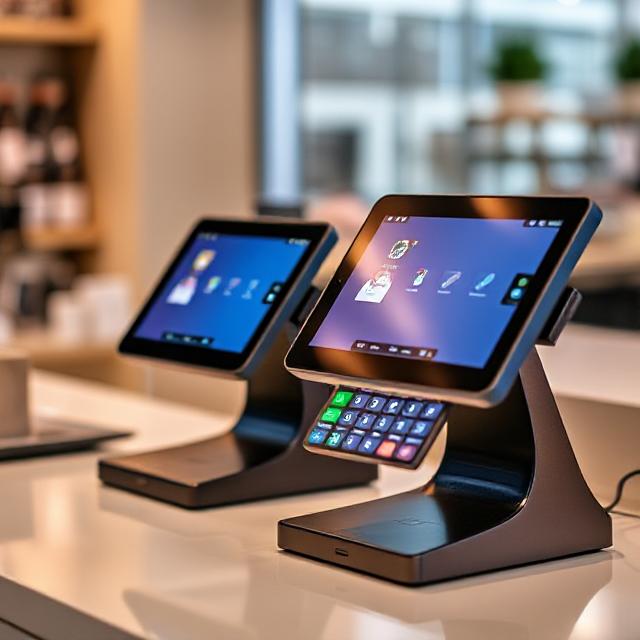How Smart POS Terminals Enhance Retail Efficiency: A Practical Guide to Multi-Payment Integration & Data Analytics
2025-07-30
Introduction
The retail landscape is undergoing a digital revolution, with Smart POS (Point of Sale) terminals emerging as a cornerstone of operational efficiency. These advanced systems go beyond traditional cash registers, integrating multi-payment processing, real-time analytics, and inventory management to streamline retail operations. By 2025, over 70% of retailers globally have adopted cloud-based or AI-powered POS systems, significantly reducing checkout times and improving customer satisfaction.
The retail landscape is undergoing a digital revolution, with Smart POS (Point of Sale) terminals emerging as a cornerstone of operational efficiency. These advanced systems go beyond traditional cash registers, integrating multi-payment processing, real-time analytics, and inventory management to streamline retail operations. By 2025, over 70% of retailers globally have adopted cloud-based or AI-powered POS systems, significantly reducing checkout times and improving customer satisfaction.
This guide explores how Smart POS terminals optimize retail workflows through multi-payment integration and data-driven decision-making, offering actionable insights for businesses aiming to stay competitive.
1. Multi-Payment Integration: Seamless & Secure Transactions
A key advantage of Smart POS systems is their ability to support diverse payment methods, including:
A key advantage of Smart POS systems is their ability to support diverse payment methods, including:
◐ Contactless payments (NFC, Apple Pay, Google Pay) – Reducing checkout time by 30% compared to traditional card swiping.
◐ Mobile wallets & QR codes – Essential for markets like Asia, where Alipay and WeChat Pay dominate.
◐ Cross-border transactions – Enabling multi-currency support for global retail expansion3.
◐ Mobile wallets & QR codes – Essential for markets like Asia, where Alipay and WeChat Pay dominate.
◐ Cross-border transactions – Enabling multi-currency support for global retail expansion3.
Why It Matters:
◐ Faster checkout: Customers spend 40% less time in queues with contactless payments.
◐ Higher approval rates: Intelligent routing algorithms select the most cost-effective payment gateway per transaction, minimizing declines3.
◐ Fraud prevention: EMV chip readers and PCI DSS compliance reduce chargebacks by encrypting data end-to-end.
◐ Faster checkout: Customers spend 40% less time in queues with contactless payments.
◐ Higher approval rates: Intelligent routing algorithms select the most cost-effective payment gateway per transaction, minimizing declines3.
◐ Fraud prevention: EMV chip readers and PCI DSS compliance reduce chargebacks by encrypting data end-to-end.
2. Real-Time Inventory Management
Smart POS systems automate inventory tracking, eliminating manual stock checks and reducing discrepancies by up to 90%. Key features include:
Smart POS systems automate inventory tracking, eliminating manual stock checks and reducing discrepancies by up to 90%. Key features include:
◐ Barcode/RFID scanning – Updates stock levels instantly after each sale.
◐ Low-stock alerts – Triggers automatic reorder requests to suppliers.
◐ Multi-location sync – Centralizes inventory data across warehouses and stores.
Case Study:
Retailers using AI-powered POS systems report a 20% reduction in overstocking and a 15% increase in sales by aligning inventory with demand trends.
Retailers using AI-powered POS systems report a 20% reduction in overstocking and a 15% increase in sales by aligning inventory with demand trends.
3. Data Analytics for Smarter Decisions
Modern POS terminals transform raw sales data into actionable insights:
◐ Customer Behavior Analysis: Tracks purchase history to personalize promotions (e.g., loyalty discounts for frequent buyers).
◐ Sales Performance Reports: Identifies top-selling products, peak hours, and underperforming SKUs.
◐ Predictive Analytics: AI algorithms forecast demand, helping retailers optimize staffing and procurement.
Modern POS terminals transform raw sales data into actionable insights:
◐ Customer Behavior Analysis: Tracks purchase history to personalize promotions (e.g., loyalty discounts for frequent buyers).
◐ Sales Performance Reports: Identifies top-selling products, peak hours, and underperforming SKUs.
◐ Predictive Analytics: AI algorithms forecast demand, helping retailers optimize staffing and procurement.
Example:
A café using POS analytics discovered that 60% of afternoon sales were cold brews, prompting them to stock more during those hours—boosting revenue by 12%.
A café using POS analytics discovered that 60% of afternoon sales were cold brews, prompting them to stock more during those hours—boosting revenue by 12%.

4. Enhancing Customer Experience
Smart POS systems improve satisfaction through:
◐ Personalized service: CRM integration enables tailored discounts based on past purchases.
◐ Self-checkout kiosks: Reduce wait times by 50% in high-traffic stores.
◐ Omnichannel consistency: Syncs online/offline sales data for seamless returns and exchanges.
Smart POS systems improve satisfaction through:
◐ Personalized service: CRM integration enables tailored discounts based on past purchases.
◐ Self-checkout kiosks: Reduce wait times by 50% in high-traffic stores.
◐ Omnichannel consistency: Syncs online/offline sales data for seamless returns and exchanges.
5. Implementation Best Practices
To maximize ROI, retailers should:
To maximize ROI, retailers should:
◐ Choose scalable POS hardware (e.g., iPad-based or Android terminals with 4G/Wi-Fi connectivity).
◐ Integrate with payment gateways (Stripe, Adyen) for global transaction support.
◐ Train staff on analytics tools to leverage data effectively.
Conclusion
Smart POS terminals are no longer optional—they are a strategic necessity for retailers. By unifying multi-payment processing, inventory automation, and AI-driven analytics, these systems cut costs, boost sales, and future-proof businesses in an increasingly digital marketplace.
Smart POS terminals are no longer optional—they are a strategic necessity for retailers. By unifying multi-payment processing, inventory automation, and AI-driven analytics, these systems cut costs, boost sales, and future-proof businesses in an increasingly digital marketplace.
Next Steps: Evaluate POS providers offering cloud-based solutions, AI integrations, and modular hardware to match your retail needs.
recommended for you
no data
Get in touch with us
Products
Contact Us
Company address: 608,Block B,Golden Valley Business Park,Longzhu 4Road,Nanshan District,Shenzhen,China
Factory address: Building 1, Phase 4, Standardization Plant for Overall Urbanization, High-tech Zone, Suzhou City, Anhui, China.
Contact person: Jason Chan
Tel: +86 181 0029 0527 / +86 135 9015 2087
WhatsApp: +86 181 0029 0527
Copyright © 2025 Shenzhen Kexin Smart Development Co.,Ltd - Privacy Policy | Sitemap





